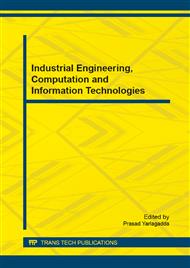[1]
Wikipedia. On Advanced persistent threat[EB/OL]. [2014-07-7]. http: /en. wikipedia. org/wiki/Advanced_Persistent_Threat.
Google Scholar
[2]
LIANG Yu1, PENG Guojun etc. An Unknown Trojan Detection Method Based on Software Network Behavior[J], Wuhan University Journal of Natural Sciences 2013, Vol. 18 No. 5 369-376.
DOI: 10.1007/s11859-013-0944-6
Google Scholar
[3]
Matrosov A, Rodionov E, Harley D, et al. Stuxnet under the microscope [EB/OL]. [2012-10-17]. http: /www. eset. com/us/resources/white-papers/stuxnet_under_the_mciroscope. pdf.
Google Scholar
[4]
Falliere N, Murchu O L, Chien E. W32. stuxnet dossier[EB/OL]. [2012-05-21]. http: /www. cert. org. cn/userfiles/file/201203192011annualreport(1). pdf.
Google Scholar
[5]
Bencsáth B, Pek G, Buttyan L, et al. Duqu: A Stuxnet-like malware found in the wild [EB/OL]. [2012-07-14]. http: /www. crysys. hu/mfelegyhazi/publications/Bencsath2011duqu. pdf.
Google Scholar
[6]
Wikipedia. on Dynamic-link library[EB/OL]. [2014-07-07] http: /en. wikipedia. org/wiki/Dynamic-link_library.
Google Scholar
[7]
S. T. Institute. Assessing outbound traffic to uncover advanced persistent threat[EB/OL]. [2013-04-14]. http: /www. sans. edu/student-files/projects/JWP-Binde-McRee-OConnor. pdf.
Google Scholar
[8]
N. Villeneuve and J. Bennet. Detecting apt activity with network traffic analysis. Visited April (2013).
Google Scholar
[9]
Perdisci R, Lee W, Feamster N. Behavioral clustering of HTTP-based malware and signature generation using malicious network traces [EB/OL]. [2011-06-14]. http: /static. usenix. org/event/nsdi10/tech/full_papers/perdisci. pdf.
Google Scholar
[10]
Brumley D, Hartwig C, Liang Z, et al. Automatically identifying trigger-based behavior in malware [J]. Botnet Detection, 2008, 36: 65-88.
DOI: 10.1007/978-0-387-68768-1_4
Google Scholar
[11]
Jiang X, Wang X, Xu D. Stealthy malware detection through vmm-based out-of-the-box semantic view reconstruction [C]/Proceedings of the 14th ACM Conference on Computer and Communications Security. New York: ACM Press, 2007: 128-138.
DOI: 10.1145/1315245.1315262
Google Scholar
[12]
Wang L, Zhang R, Zhang S. A model of computer live forensics based on physical memory analysis[C]/Information Science and Engineering (ICISE), 2009 1st International Conference on. IEEE, 2009: 4647-4649.
DOI: 10.1109/icise.2009.69
Google Scholar
[13]
BILBY D, Low down and dirty: anti-forensic rootkits, Proceedings of Ruxcon, (2006).
Google Scholar
[14]
Hejazi S. M, Talhi C, Debbabi M, Extraction of forensically sensitive information from windows physical memory, Digital Investigation 6 2009: S121-S131.
DOI: 10.1016/j.diin.2009.06.003
Google Scholar
[15]
James Okolica, Gilbert L. Peterson, Windows operating systems agnostic memory analysis Digital Investigation7 2010: S48-S56.
DOI: 10.1016/j.diin.2010.05.007
Google Scholar
[16]
Richard M. Stevens , Eoghan Casey, Extracting Windows command line details from physical memory, Digital Investigation 7 2010: S57-S63.
DOI: 10.1016/j.diin.2010.05.008
Google Scholar
[17]
Vivienne Mee, Theodore Tryfonas, Iain Sutherland, The Windows Registry as a forensic artefact: Illustrating evidence collection for Internet usage, Digital Investigation 3 2006: I66-I73.
DOI: 10.1016/j.diin.2006.07.001
Google Scholar
[18]
Brendan Dolan-Gavitt, Forensic analysis of the Windows registry in memory, Digital Investigation 5 (2008)S26-S32.
DOI: 10.1016/j.diin.2008.05.003
Google Scholar
[19]
Shuhui Zhang, Lianhai Wang, Lei Zhang, Extracting windows registry information from physical memory, Computer Research and Development (ICCRD), 2011 3rd International Conference on Issue Date: 11-13 March 2011: 85 - 89.
DOI: 10.1109/iccrd.2011.5764089
Google Scholar
[20]
Andreas Schuster Searching for Processes and Threads in Microsoft Windows Memory Dumps[C/OL], Proceedings of the 2006 Digital Forensic Research Workshop (DFRWS), 2006 http: /www. dfrws. org/2006/proceedings/2-Schuster. pdf.
DOI: 10.1016/j.diin.2006.06.010
Google Scholar
[21]
WALTERS A., PETRONNI Jr NL. Volatools: Integrating volatile Memory Forensics into the Digital Investigation Process[C/OL] In: Black Hat DC 2007; 2007 http: /www. blackhat. com/presentations/bh-dc-07/Walters/Paper/bh-dc-07-Walters-WP. pdf.
Google Scholar
[22]
Zhang Lei, Wang Lianhai, Zhang Shuhui , Live Memory acquisition through Firewire[J], China Communications, vol. 6, 71-77, (2010).
Google Scholar
[23]
Wang Lianhai, Xu lijuan, Zhang Shuhui , A Method on Extracting Network Connection Information from 64-bit Windows 7 Memory Images[J], China Communications, vol. 6, 44-51, (2010).
Google Scholar
[24]
Xu lijuan, Wang Lianhai, Zhang Lei . Acquisition of Network connection Status Information from Physical memory on Windows vista Operating system[J], China Communications, vol. 6, 71-77, (2010).
Google Scholar


